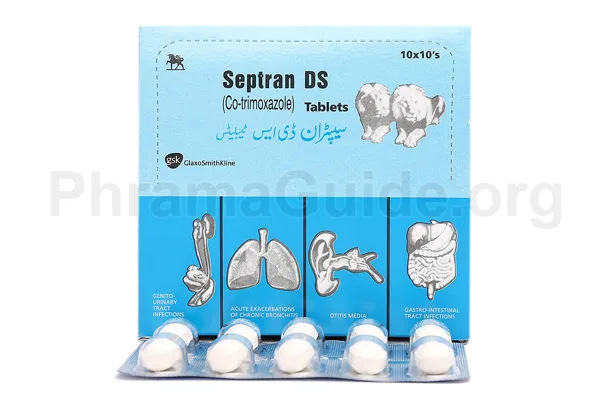Septran tablet is primarily used to treat and prevent various bacterial infections. It is a combination of two antibiotics that provides strong effects against bacterial infections, including:
- Urinary Tract Infections (UTIs): Septran tablet is often used for the treatment of UTIs caused by susceptible bacteria.
- Respiratory Tract Infections: Septran tablets can be used to treat respiratory tract infections, such as bronchitis and pneumonia, caused by susceptible bacteria.
- Ear and Sinus Infections: Septran tablet is sometimes used to treat infections of the ear or sinuses caused by susceptible bacteria.
- Traveler’s Diarrhea: In certain cases, Septran tablets may be used to prevent or treat traveler’s diarrhea caused by specific bacteria.
- Pneumocystis Pneumonia (PCP): Septran tablet is also used for the treatment and prevention of PCP, which is a severe lung infection that commonly affects individuals with weakened immune systems, such as those with HIV/AIDS.
- Toxoplasmosis: Septran tablets can be used as part of the treatment regimen for toxoplasmosis, a parasitic infection that can affect individuals with compromised immune systems.
Off-label Uses of Septran Tablet
- Skin and Soft Tissue Infections: Septran tablets may be used off-label to treat certain types of skin and soft tissue infections caused by susceptible bacteria, such as cellulitis.
- Acne: In some cases, Septran tablets can be used for the treatment of severe or persistent acne that has not responded to other treatments. It can help reduce inflammation and control bacterial growth associated with acne.
- Prostatitis: Septran tablets may be used to treat chronic bacterial prostatitis, a condition characterized by inflammation of the prostate gland due to bacterial infection.
- Whipple’s Disease: Septran tablets may be used as part of the treatment regimen for Whipple’s disease, a rare bacterial infection that primarily affects the small intestine.

What is Septran?
Septran is a leading brand of Co-trimoxazole (also known as trimethoprim/sulfamethoxazole), manufactured and marketed by GlaxoSmithKline (GSK).
Septran Alternatives : Other Similar Brands
The following are some alternative brands of Septran and their manufacturers.
- Nicotrim : Ray Pharma (Pvt) Ltd, Pakistan.
- Bactrim : Roche (Pakistan) Limited.
- Cotrim : Tabros Pharma, Pakistan.
- Boschtrim : Bosch Pharmaceuticals (Pvt) Ltd, Pakistan.
- Cotri : Unexo Labs (Pvt) Ltd, Pakistan.
- Eftran : Efroze Chemical Industries (Pvt) Ltd, Pakistan.
- Infectran : Zafa Pharmaceutical Laboratories (Pvt) Ltd, Pakistan.
- Supracombin : Searle Pakistan (Pvt) Ltd.
- Wiltran : Wilshire Laboratories (Pvt) Ltd, Pakistan.
- Suptrex : The Schzoo Laboratories Ltd, Pakistan.
Septran : Available Formulations and Strengths
Presently, Septran is available in Tablets and Suspensions forms with the following strengths.
Septran Tablet : Sulfamethoxazole 400mg + Trimethoprim 80mg strength
Septran Syrup : Sulfamethoxazole 200mg/5ml + Trimethoprim 40mg/5ml strength
Septran DS Tablet : Sulfamethoxazole 800mg + Trimethoprim 160mg strength
Septran DS Syrup : Sulfamethoxazole 400mg/5ml + Trimethoprim 80mg/5ml strength
Who Should Not Use Septran?
Septran has some contraindications, and its use should be avoided in the following situations:
Hypersensitivity or allergy: Septran should not be used in individuals who have a known hypersensitivity or allergy to any component of Septran. Allergic reactions to Septran can range from mild skin rashes to severe anaphylaxis.
Severe liver or kidney disease: Septran is primarily eliminated from the body through the kidneys and can accumulate in individuals with severe kidney impairment. It should be used with caution or avoided in patients with severe liver or kidney disease.
Pregnancy and breast-feeding: Septran is generally not recommended during pregnancy, especially during the first trimester, as it may cause harm to the developing fetus. It can also pass into breast milk and may cause adverse effects in nursing infants.
Deficiency of the enzyme glucose-6-phosphate dehydrogenase (G6PD): Septran can cause hemolysis (breakdown of red blood cells) in individuals with G6PD deficiency, a hereditary condition. It should be used with caution or avoided in these individuals.
Porphyria: Septran can trigger acute attacks of porphyria, a group of rare genetic disorders that affect the production of heme, an essential component of hemoglobin. Sptran should be avoided in individuals with known porphyria.
What is the Recommended Daily Dosage of Septran?
Septran Dose in Adults:
-
- For urinary tract infections (uncomplicated): The typical dose is 1 tablet of Septran DS twice daily, or 2 tablets of Septran every 12 hours.
- For respiratory tract infections, gastrointestinal infections, and other bacterial infections: The typical dose is 1 tablet of Septran DS twice daily, or 2 tablets of Septran every 12 hours.
Septran Dose in Children:
-
- The dosage for children is based on their body weight. The healthcare professional will determine the appropriate dose and frequency of administration based on the child’s age, weight, and the specific infection being treated.
How Septran Works?
The mode of action depends on its active ingredients.
- Sulfamethoxazole: Sulfamethoxazole belongs to a class of antibiotics known as sulfonamides. It acts as a competitive inhibitor of dihydropteroate synthase, an enzyme involved in the synthesis of folic acid in bacteria. By inhibiting this enzyme, sulfamethoxazole disrupts the production of folic acid, which is an essential nutrient for bacteria to synthesize nucleic acids (DNA and RNA) and proteins. Without sufficient folic acid, bacterial growth and reproduction are hindered, inhibiting bacterial proliferation.
- Trimethoprim: Trimethoprim is a dihydrofolate reductase inhibitor. It targets the enzyme dihydrofolate reductase, which plays a crucial role in the synthesis of tetrahydrofolate, a necessary precursor for the production of DNA, RNA, and amino acids in bacteria. By inhibiting dihydrofolate reductase, trimethoprim disrupts the conversion of dihydrofolate to tetrahydrofolate, leading to a depletion of folate derivatives required for bacterial growth and replication.

Leave A Comment